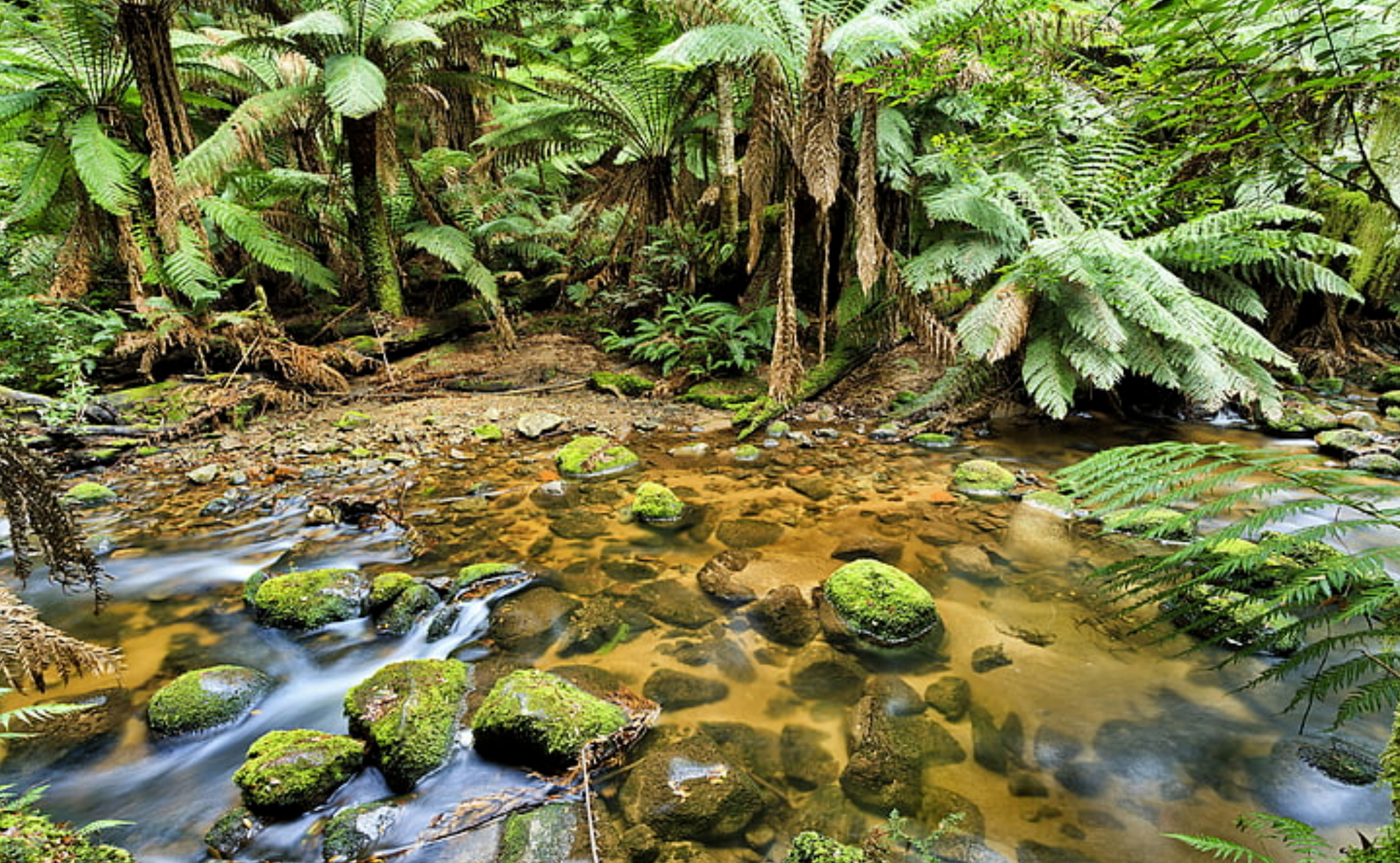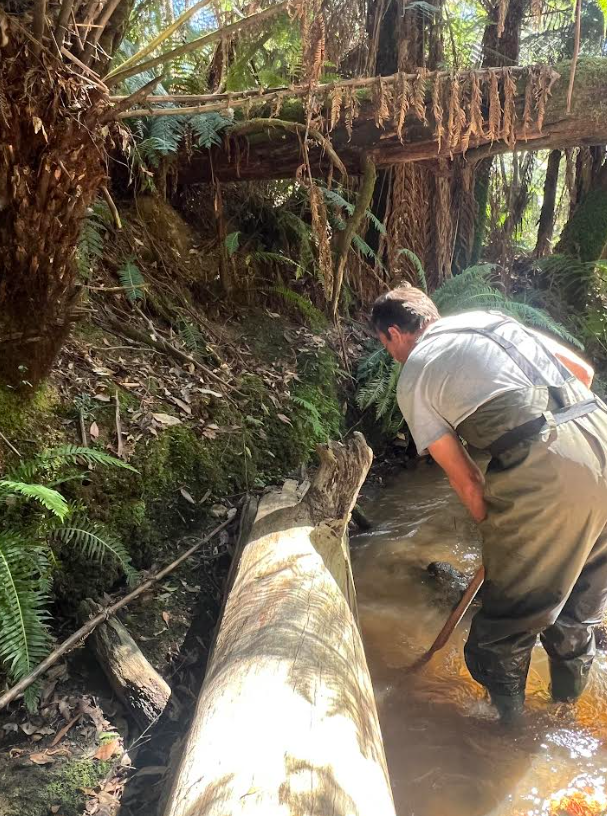Tasmanian Sapphires: Unearthing the Island’s Hidden Gemstones
By Lisa Millwood | FGAA Gemmologist & NCJV Registered Valuer | Launceston, Tasmania
Tasmania’s rugged landscape hides more than breathtaking wilderness — it holds a glittering legacy of sapphires, zircons, and topaz, waiting to be discovered in ancient riverbeds and weathered gravels.
For gem lovers, history buffs, and fossicking enthusiasts, the northeast of Tasmania offers a unique blend of geological beauty and fascinating mining history. Whether you're looking to fossick for your own gemstones or learn about their historical significance, this guide has everything you need.
A fern-lined creek with mossy rocks and hidden treasures below.
💎 The Historical Backdrop: Tin Mining & the Birth of Gem Discovery
In the late 1800s, the tin mining boom in Tasmania’s northeast sparked a rush that would permanently shape the region — geologically, economically, and culturally.
Tin Mining in the Blue Tier & Weld River Regions
Areas like Derby, Moorina, and the Blue Tier became central to Tasmania’s tin mining industry, drawing settlers and prospectors seeking fortune.
During tin extraction, miners discovered “unusual crystals” in river gravels — these turned out to be sapphires, zircons, and topaz, often overlooked or discarded with the wash.
Over time, collectors and gemmologists began to realize the significance of these stones — and thus, Tasmania’s gem fossicking culture was born.
Archival image of mining
🟦 Tasmanian Sapphires: Colours, Types & Origins
Tasmanian sapphires are typically alluvial, meaning they’ve been weathered out of basaltic or metamorphic host rocks and transported into river systems. Most people are surprised to learn that the current landscape where these sapphires are found is not the original environment. Instead it has been heavily mined by water cannons, transported by water races and transformed by mining and time into what we see today.
What to Expect:
Colours: Classic inky blue, green-blue blends, golden yellows, small pinks and sometimes parti-colours.
Size: Most are small but can yield cuttable stones with excellent clarity. Bigger stones are rare and are usually a very dark blue.
Origin: Formed deep within the Earth’s crust and washed into rivers like the Weld (which is why a lot of miners like to go after flooding).
✨ Other Gemstones Found in Tasmania
You're rarely just fossicking for one gem. Alongside sapphires, you can also uncover:
Zircons – Fabulous reds (normally found in the North West), pinks, oranges and browns, these are found abundantly in the same alluvial gravels.
Topaz – Known locally as "Killiecrankie Diamonds", Tasmania’s topaz occurs mostly on Flinders Island in clear or pale blue hues but are also found in Tasmania.
Quartz varieties – Smoky quartz, amethyst, and even small garnets can occasionally be found in fossicking zones.
Black spinel - Known locally as Black Jack, this is a glossy opaque black material that can be found in large sizes.
Tourmaline - Usually black and can be easily confused with black spinel.
Chrysoberyl - A yellowish green precious gem, easily confused with sapphire.
Peridot - Annother green gem and relatively rare in Tasmania. It’s not as valuable as sapphire or chrysoberyl though.
📍 Where to Fossick in Tasmania
Here are the most accessible and rewarding fossicking spots for gemstones:
1. Weld River Fossicking Area (Moorina)
Best known for sapphires, zircons, and occasional topaz.
Public access is allowed; fossicking is permitted using hand tools only.
Part of the former tin mining zones — many discoveries are from the tailings of old operations.
2. Gladstone
Visit the Gladstone area which has yielded good specimens of smoky quartz, clear quartz, amethyst, topaz and jasper.
This area is particularly renowned for large crystals of smoky quartz.
3. Killiecrankie Bay (Flinders Island)
Topaz-rich gravels found along beach and creek beds.
Accessible via ferry or plane to Flinders Island; fossicking in designated areas is permitted.
🪪 Do You Need a Licence?
Fossicking for personal use does not require a licence in designated fossicking areas in Tasmania. However, for broader exploration or any commercial intent, you must apply for a Prospecting Licence.
🔹 How to Apply:
Visit: Service Tasmania – Prospecting Licence
Alternatively, check guidelines and fossicking maps on the Mineral Resources Tasmania (MRT) website. Apply here.
🧰 What to Bring When Fossicking
Sieve and shovel
Small trowel or pick
Water container and food
Tweezers and a loupe for field inspections
Ziplock bags or gem jars for keeping finds
Waders or a wetsuit if possible to keep warm
Salt - for the leaches!
Pro Tip: Watch Utube videos to see how the pro’s do it and to give yourself an idea of what to expect before you go.
Be prepared to get wet, dig deep holes and learn an appreciation for how hard it is to find gemstones.
🌿 A Sustainable Approach to Gem Hunting
As a gemmologist and valuer, I encourage a mindful, sustainable approach to fossicking:
Leave No Trace: Refill holes, pack out rubbish, and respect flora/fauna.
Know What You Find: If unsure, have your gemstones assessed by a qualified gemmologist.
Ethical Practices: Tasmania offers some of the most environmentally friendly gem sourcing in the world — no large-scale equipment or destructive mining needed.
🔍 Want Help Identifying Your Finds?
I offer gemstone identification and valuation services from my studio in Launceston, Tasmania. Whether you're curious about the value of a stone you found, looking to have it cut or set, or wondering whether it’s a sapphire or zircon — I can assist.
📩 Get in touch here
📍 Available by appointment in Launceston or online.
Final Thoughts
Tasmania’s rich tin mining past inadvertently uncovered one of the island’s quietest natural treasures — a legacy of hidden gems just waiting to be rediscovered by hand, not machinery.
Whether you're fossicking for fun, seeking ethical gemstones, or preserving family heirlooms, Tasmanian sapphires offer a rare and authentic connection to both the land and its history.


